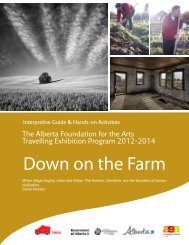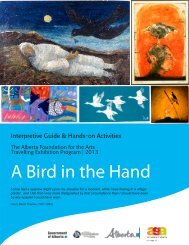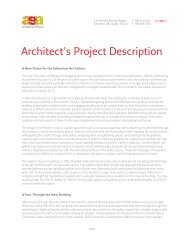Urban Animals - Art Gallery of Alberta
Urban Animals - Art Gallery of Alberta
Urban Animals - Art Gallery of Alberta
You also want an ePaper? Increase the reach of your titles
YUMPU automatically turns print PDFs into web optimized ePapers that Google loves.
The <strong>Alberta</strong> Foundation for the <strong>Art</strong>s Travelling Exhibition Program<br />
Animal Studies: Beaver continued<br />
The habitat <strong>of</strong> the beaver is the riparian zone, inclusive <strong>of</strong> stream beds. The actions <strong>of</strong><br />
beavers for hundreds <strong>of</strong> thousands <strong>of</strong> years in the Northern Hemisphere have kept these watery<br />
systems healthy and in good repair. The beaver works as a keystone species in an ecosystem<br />
by creating wetlands that are used by many other species. Next to humans, no other animal<br />
appears to do more to shape its landscape.<br />
Beavers fell trees for several reasons. They fell large, mature trees, usually in strategic<br />
locations, to form the basis <strong>of</strong> a dam. Beavers fell small trees, especially young second-growth<br />
trees, for food. Beaver dams are created as a protection against predators, such as coyotes,<br />
wolves and bears, and to provide easy access to food during winter. Beavers always work at<br />
night and are prolific builders, carrying mud and stones with their fore-paws and timber between<br />
their teeth. The ponds, created by well-maintained dams, help isolate the beavers’ homes.<br />
Beaver lodges are created from severed<br />
branches and mud. The beavers cover their<br />
lodges late every autumn with fresh mud,<br />
which freezes when the frost sets in. The<br />
mud becomes almost as hard as stone, and<br />
neither wolves nor wolverines can penetrate<br />
it. The lodge has underwater entrances to<br />
make entry nearly impossible for any other<br />
animals. A very small amount <strong>of</strong> the lodge is<br />
actually used as a living area.<br />
The basic social unit <strong>of</strong> beavers are families consisting <strong>of</strong> an adult male and adult female<br />
in a monogamous pair and their kits and yearlings. Beaver families can have as many as ten<br />
members in addition to the monogamous pair. Beaver pairs mate for life: however, if a beaver’s<br />
mate dies, it will partner with another one. In addition to being monogamous, both the male and<br />
female take part in raising <strong>of</strong>fspring. When young are born they spend their first month in the<br />
lodge and their mother is the primary caretaker while their father maintains the territory. After the<br />
young leave the lodge for the first time yearlings will help their parents build food caches in the<br />
fall and repair dams and lodges. Older <strong>of</strong>fspring, which are around two years old, may also live<br />
in families and help their parents. In addition to helping build food caches and repairing the dam,<br />
two-year olds will also help in feeding and grooming and guarding the younger <strong>of</strong>fspring.<br />
Beavers maintain and defend territories, which are areas for feeding, nesting and mating.<br />
They mark their territories by constructing scent mounds made <strong>of</strong> mud, debris and castoreum,<br />
a urine based substance excreted through the beaver’s castor sacs between the pelvis and the<br />
base <strong>of</strong> the tail. These scent mounds are established on the border <strong>of</strong> the territory. Because they<br />
invest so much energy in their territories beavers are intolerant <strong>of</strong> intruders and the holder <strong>of</strong> the<br />
territory is more likely to escalate an aggressive encounter.<br />
AFA Travelling Exhibition Program, Edmonton, AB. Ph: 780.428.3830 Fax: 780.421.0479<br />
youraga.ca

















